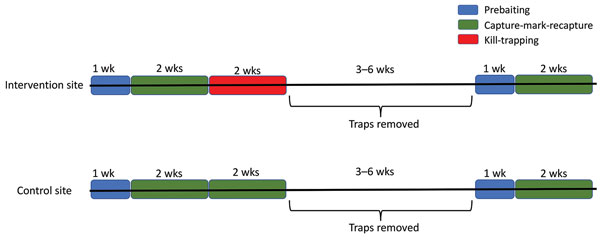Volume 24, Number 2—February 2018
Dispatch
Effects of Culling on Leptospira interrogans Carriage by Rats
Figure 2

Figure 2. Experiment timeline in intervention and control sites in a study of the effects of culling on Leptospira interrogans carriage by rats, Vancouver, British Columbia, Canada, June 2016–January 2017. Trapping in each intervention site was divided into three 2-week periods: the period before kill-trapping, the period during kill-trapping, and the period after kill-trapping. During the 2 weeks before kill-trapping, we captured and sampled rats, gave them all a unique ear-tag identifier, and then released them where they were caught. In the following 2 weeks (the kill-trapping period) rats that were caught in the center of the 3 blocks were euthanized; catch-release continued in flanking blocks. Traps were then removed for >3–6 weeks, after which they were returned to their exact prior locations, and capture-sample-release continued for 2 more weeks (the period after kill-trapping). The trapping protocol was the same for control blocks except that capture-sample-release was conducted during all 2-week trapping periods. Prebaiting (during which traps were fixed open) was used to acclimate rats to cages (Technical Appendix).